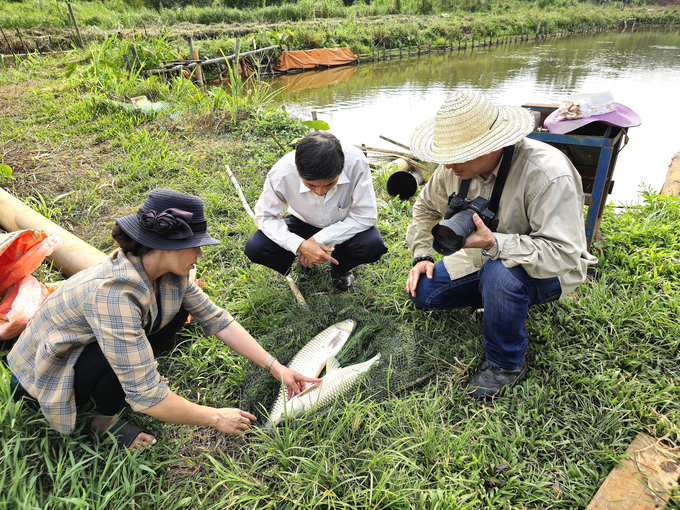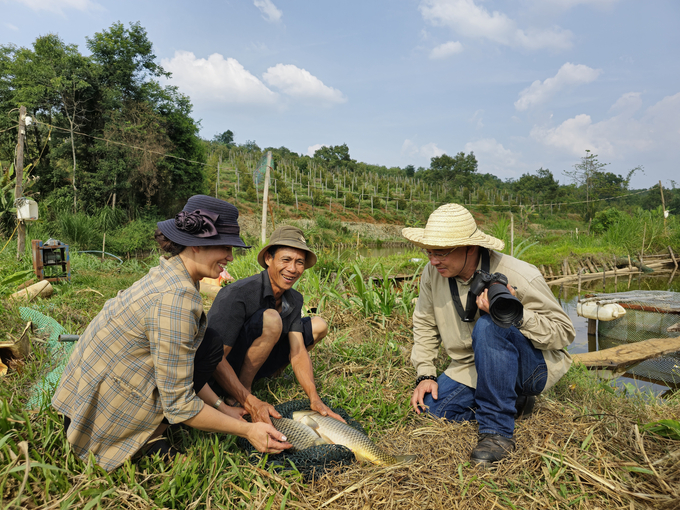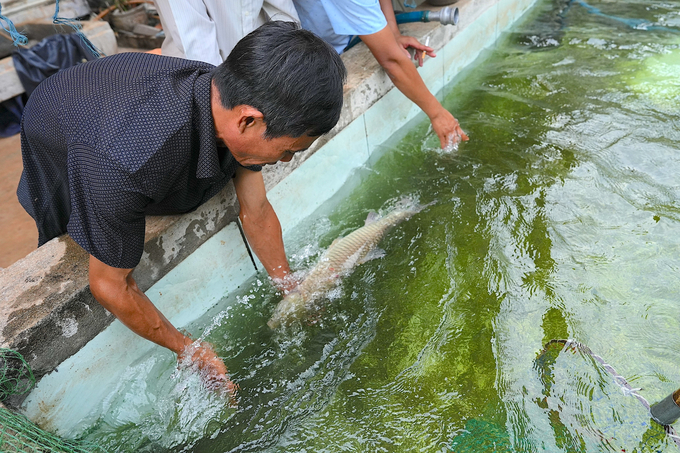November 18, 2025 | 23:23 GMT +7
November 18, 2025 | 23:23 GMT +7
Hotline: 0913.378.918
November 18, 2025 | 23:23 GMT +7
Hotline: 0913.378.918
This method, rare in Vietnam's Central Highlands, sets them apart as their district's only successful “crunchy carp” producers. The technique involves feeding the fish a special diet of fava beans after they reach a certain weight, turning their meat from tender to firm and highly sought-after by restaurants and traders alike.

Ms. Pham Thi Tam lifts a freshly harvested crunchy grass carp from the net enclosure in the pond to show to customers. Photo: HT.
Driven by a shared passion for fish farming, Diep and Tam began cultivating carp over five years ago and soon transitioned to the “crunchy” variety after discovering it during a trip to Hai Duong. Their decision to invest in this method led them to redesign their fishponds and secure a stable fava bean supply. Their process starts with raising the carp to a weight of 1-2 kg, then moving them to another pond to feed exclusively on fava beans for eight months, achieving the desired texture and quality.

Ms. Tam discusses the types of fungi that commonly affect crunchy grass carp and shares her expertise on prevention and treatment methods. Photo: BT.

Ms. Tam and her husband hold a pair of crunchy carp, each weighing 4 kg. Photo: BT.
Their fish are in high demand, eliminating the need for market trips; buyers come directly to them. In 2023, they produced around 10 tons of "crunchy" carp, generating over 1.8 billion VND in revenue, although expenses halved their net earnings. To maintain fish health over a lengthy growth period, especially during dry seasons, they use biological agents to purify the pond water, control pH levels, and prevent diseases common to carp, like fungal infections and parasites. They also use neem leaves for natural parasite control and adjust water chemistry using lime.

Mr. Diep brings freshly harvested crunchy grass carp and carp from the pond to a tank in the yard, allowing customers to buy directly without needing to travel several kilometers to the pond. Photo: HT.
Their venture has gained recognition, with local agricultural departments highlighting their success as a model for other farmers. Today, their farm has become a point of interest for visitors and aspiring farmers, as they share the knowledge and skills they've accumulated through both practical experience and expert training. Their success in this niche market demonstrates the potential of specialized, high-quality fish farming in remote areas of Vietnam.
Translated by Linh Linh

(VAN) Deputy Prime Minister Tran Hong Ha convened a meeting with the MAE and relevant agencies to discuss the draft decree on national multidimensional poverty standards for the 2026 - 2030 period.

(VAN) The year 2025 marks the 10th anniversary since more than 190 countries adopted the Paris Agreement on climate change, paving the way for strengthened global action.

(VAN) The PepsiCo Foundation funded the project ‘New Harvest: Sustainable Agriculture Initiative’, focusing on regenerative agriculture and climate change.

(VAN) Dr. Nguyen Viet Hung, ILRI's Regional Director for Asia, emphasized the One Health approach in ensuring food safety and reducing antimicrobial resistance risks in livestock.

(VAN) The youth-driven initiative ‘Innovate for water, act for the future’ seeks practical, scalable solutions to Vietnam’s water challenges.

(VAN) At the Annual Science Conference of Thuyloi University, Deputy Minister Phung Duc Tien directed researchers to focus on in-depth studies, data harmonization, and solutions linked to real-world practice.

(VAN) After nearly four years of implementation, 5,187 community agricultural extension groups have been established nationwide, with 47,493 members participating.